seats LINCOLN MKS 2016 Owners Manual
[x] Cancel search | Manufacturer: LINCOLN, Model Year: 2016, Model line: MKS, Model: LINCOLN MKS 2016Pages: 382, PDF Size: 3.81 MB
Page 4 of 382
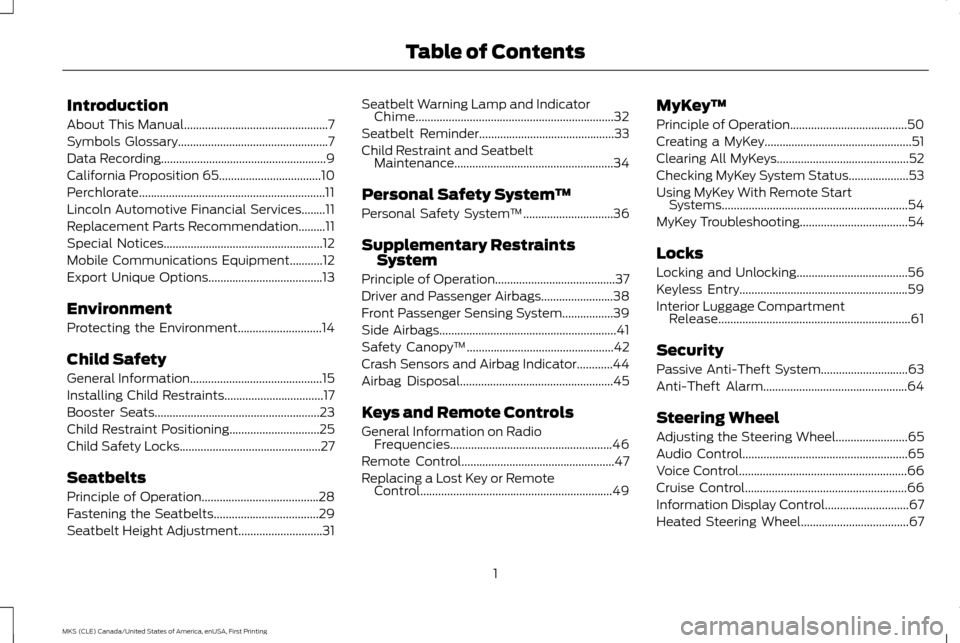
Introduction
About This Manual................................................7
Symbols Glossary..................................................7
Data Recording.......................................................9
California Proposition 65
..................................10
Perchlorate..............................................................11
Lincoln Automotive Financial Services........11
Replacement Parts Recommendation.........11
Special Notices
.....................................................12
Mobile Communications Equipment...........12
Export Unique Options......................................13
Environment
Protecting the Environment............................14
Child Safety
General Information............................................15
Installing Child Restraints.................................17
Booster Seats.......................................................23
Child Restraint Positioning
..............................25
Child Safety Locks
...............................................27
Seatbelts
Principle of Operation.......................................28
Fastening the Seatbelts
...................................29
Seatbelt Height Adjustment............................31 Seatbelt Warning Lamp and Indicator
Chime..................................................................32
Seatbelt Reminder
.............................................33
Child Restraint and Seatbelt Maintenance.....................................................34
Personal Safety System ™
Personal Safety System ™
..............................36
Supplementary Restraints System
Principle of Operation
........................................37
Driver and Passenger Airbags........................38
Front Passenger Sensing System.................39
Side Airbags...........................................................41
Safety Canopy ™
.................................................42
Crash Sensors and Airbag Indicator............44
Airbag Disposal
...................................................45
Keys and Remote Controls
General Information on Radio Frequencies......................................................46
Remote Control...................................................47
Replacing a Lost Key or Remote Control................................................................49 MyKey
™
Principle of Operation.......................................50
Creating a MyKey
.................................................51
Clearing All MyKeys............................................52
Checking MyKey System Status....................53
Using MyKey With Remote Start Systems..............................................................54
MyKey Troubleshooting....................................54
Locks
Locking and Unlocking.....................................56
Keyless Entry........................................................59
Interior Luggage Compartment Release................................................................61
Security
Passive Anti-Theft System.............................63
Anti-Theft Alarm................................................64
Steering Wheel
Adjusting the Steering Wheel
........................65
Audio Control
.......................................................65
Voice Control
........................................................66
Cruise Control
......................................................66
Information Display Control............................67
Heated Steering Wheel....................................67
1
MKS (CLE) Canada/United States of America, enUSA, First Printing Table of Contents
Page 5 of 382
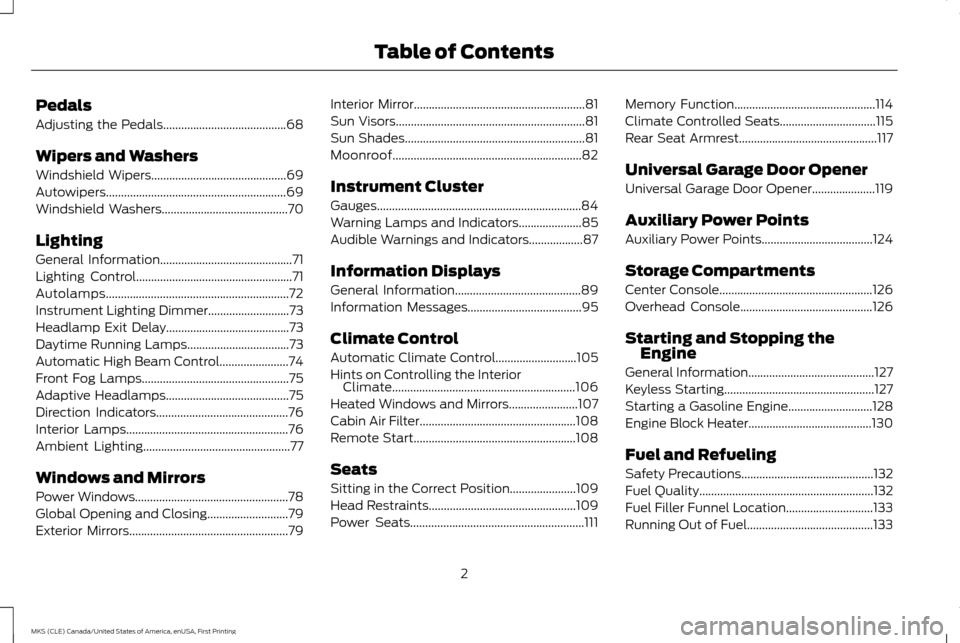
Pedals
Adjusting the Pedals.........................................68
Wipers and Washers
Windshield Wipers.............................................69
Autowipers............................................................69
Windshield Washers
..........................................70
Lighting
General Information
............................................71
Lighting Control
....................................................71
Autolamps.............................................................72
Instrument Lighting Dimmer...........................73
Headlamp Exit Delay.........................................73
Daytime Running Lamps..................................73
Automatic High Beam Control
.......................74
Front Fog Lamps.................................................75
Adaptive Headlamps.........................................75
Direction Indicators
............................................76
Interior Lamps
......................................................76
Ambient Lighting
.................................................77
Windows and Mirrors
Power Windows
...................................................78
Global Opening and Closing
...........................79
Exterior Mirrors.....................................................79 Interior Mirror
.........................................................81
Sun Visors
...............................................................81
Sun Shades
............................................................81
Moonroof...............................................................82
Instrument Cluster
Gauges....................................................................84
Warning Lamps and Indicators.....................85
Audible Warnings and Indicators..................87
Information Displays
General Information..........................................89
Information Messages
......................................95
Climate Control
Automatic Climate Control
...........................105
Hints on Controlling the Interior Climate.............................................................106
Heated Windows and Mirrors
.......................107
Cabin Air Filter....................................................108
Remote Start......................................................108
Seats
Sitting in the Correct Position......................109
Head Restraints
.................................................109
Power Seats..........................................................111 Memory Function
...............................................114
Climate Controlled Seats
................................115
Rear Seat Armrest..............................................117
Universal Garage Door Opener
Universal Garage Door Opener.....................119
Auxiliary Power Points
Auxiliary Power Points
.....................................124
Storage Compartments
Center Console
...................................................126
Overhead Console
............................................126
Starting and Stopping the Engine
General Information
..........................................127
Keyless Starting..................................................127
Starting a Gasoline Engine
............................128
Engine Block Heater.........................................130
Fuel and Refueling
Safety Precautions
............................................132
Fuel Quality
..........................................................132
Fuel Filler Funnel Location.............................133
Running Out of Fuel..........................................133
2
MKS (CLE) Canada/United States of America, enUSA, First Printing Table of Contents
Page 7 of 382

Ordering Additional Owner's
Literature.........................................................220
Reporting Safety Defects (U.S. Only).......220
Reporting Safety Defects (Canada Only)...................................................................221
Fuses
Fuse Specification Chart...............................223
Changing a Fuse................................................237
Maintenance
General Information
.......................................240
Opening and Closing the Hood..................240
Under Hood Overview - 3.5L Ecoboost™.....................................................242
Under Hood Overview - 3.7L........................244
Engine Oil Dipstick...........................................245
Engine Oil Check...............................................245
Oil Change Indicator Reset...........................246
Engine Coolant Check.....................................247
Automatic Transmission Fluid Check......250
Brake Fluid Check.............................................254
Power Steering Fluid Check.........................254
Washer Fluid Check
.........................................254
Fuel Filter
.............................................................255
Changing the 12V Battery..............................255
Checking the Wiper Blades...........................257 Changing the Wiper Blades..........................257
Adjusting the Headlamps.............................258
Changing a Bulb
...............................................259
Bulb Specification Chart
...............................260
Changing the Engine Air Filter.....................262
Vehicle Care
General Information........................................263
Cleaning Products............................................263
Cleaning the Exterior
......................................264
Waxing
..................................................................265
Cleaning the Engine........................................265
Cleaning the Windows and Wiper Blades
...............................................................265
Cleaning the Interior
.......................................266
Cleaning the Instrument Panel and Instrument Cluster Lens............................266
Cleaning Leather Seats..................................267
Repairing Minor Paint Damage...................267
Cleaning the Alloy Wheels...........................268
Vehicle Storage
.................................................268
Wheels and Tires
Tire Care...............................................................270
Using Snow Chains
..........................................285
Tire Pressure Monitoring System...............286 Changing a Road Wheel................................289
Technical Specifications...............................294
Capacities and Specifications
Engine Specifications - 3.5L
Ecoboost™....................................................296
Engine Specifications - 3.7L.........................297
Motorcraft Parts - 3.5L Ecoboost™..........298
Motorcraft Parts - 3.7L...................................299
Vehicle Identification Number....................299
Vehicle Certification Label...........................300
Transmission Code Designation..................301
Capacities and Specifications - 3.5L Ecoboost™....................................................302
Capacities and Specifications - 3.7L.........307
Audio System
General Information.........................................313
Audio Unit - Vehicles With: Premium AM/ FM/CD...............................................................314
Media Hub
............................................................316
Accessories
Accessories..........................................................317
Extended Service Plan (ESP)
Extended Service Plan (ESP).......................319
4
MKS (CLE) Canada/United States of America, enUSA, First Printing Table of Contents
Page 15 of 382
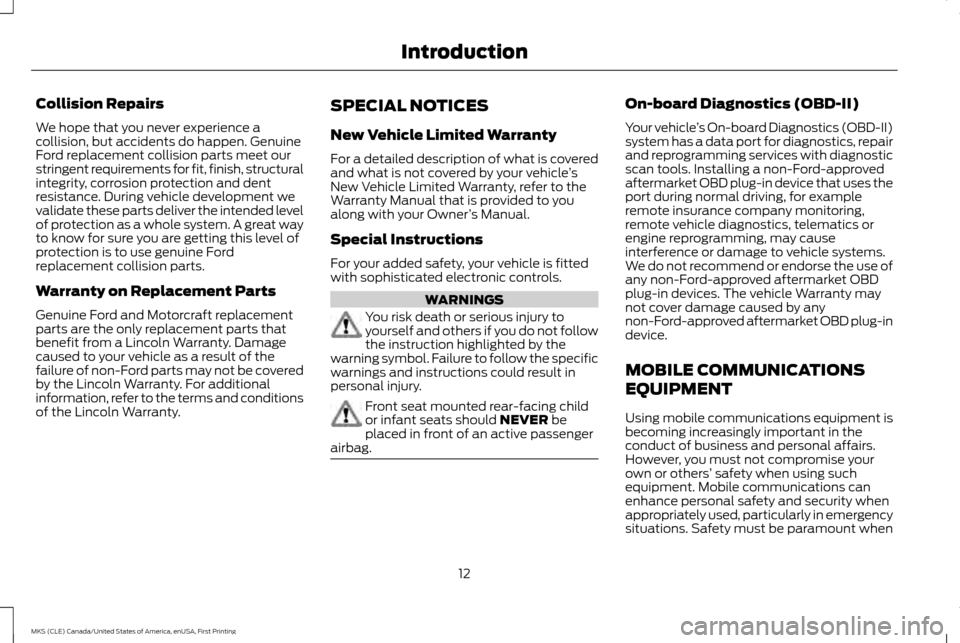
Collision Repairs
We hope that you never experience a
collision, but accidents do happen. Genuine
Ford replacement collision parts meet our
stringent requirements for fit, finish, structural
integrity, corrosion protection and dent
resistance. During vehicle development we
validate these parts deliver the intended level
of protection as a whole system. A great way
to know for sure you are getting this level of
protection is to use genuine Ford
replacement collision parts.
Warranty on Replacement Parts
Genuine Ford and Motorcraft replacement
parts are the only replacement parts that
benefit from a Lincoln Warranty. Damage
caused to your vehicle as a result of the
failure of non-Ford parts may not be covered
by the Lincoln Warranty. For additional
information, refer to the terms and conditions
of the Lincoln Warranty.
SPECIAL NOTICES
New Vehicle Limited Warranty
For a detailed description of what is covered
and what is not covered by your vehicle
’s
New Vehicle Limited Warranty, refer to the
Warranty Manual that is provided to you
along with your Owner ’s Manual.
Special Instructions
For your added safety, your vehicle is fitted
with sophisticated electronic controls. WARNINGS
You risk death or serious injury to
yourself and others if you do not follow
the instruction highlighted by the
warning symbol. Failure to follow the specific
warnings and instructions could result in
personal injury. Front seat mounted rear-facing child
or infant seats should NEVER be
placed in front of an active passenger
airbag. On-board Diagnostics (OBD-II)
Your vehicle
’s On-board Diagnostics (OBD-II)
system has a data port for diagnostics, repair
and reprogramming services with diagnostic
scan tools. Installing a non-Ford-approved
aftermarket OBD plug-in device that uses the
port during normal driving, for example
remote insurance company monitoring,
remote vehicle diagnostics, telematics or
engine reprogramming, may cause
interference or damage to vehicle systems.
We do not recommend or endorse the use of
any non-Ford-approved aftermarket OBD
plug-in devices. The vehicle Warranty may
not cover damage caused by any
non-Ford-approved aftermarket OBD plug-in
device.
MOBILE COMMUNICATIONS
EQUIPMENT
Using mobile communications equipment is
becoming increasingly important in the
conduct of business and personal affairs.
However, you must not compromise your
own or others’ safety when using such
equipment. Mobile communications can
enhance personal safety and security when
appropriately used, particularly in emergency
situations. Safety must be paramount when
12
MKS (CLE) Canada/United States of America, enUSA, First Printing Introduction
Page 18 of 382

GENERAL INFORMATION
See the following sections for directions on
how to properly use safety restraints for
children.
WARNINGS
Always make sure your child is secured
properly in a device that is appropriate
for their height, age and weight. Child
safety restraints must be bought separately
from your vehicle. Failure to follow these
instructions and guidelines may result in an
increased risk of serious injury or death to
your child. WARNINGS
All children are shaped differently. The
recommendations for safety restraints
are based on probable child height, age
and weight thresholds from the National
Highway Traffic Safety Administration and
other safety organizations, or are the
minimum requirements of law. We
recommend checking with a NHTSA Certified
Child Passenger Safety Technician (CPST)
and consult your pediatrician to make sure
your child seat is appropriate for your child,
and is compatible with and properly installed
in your vehicle. To locate a child seat fitting
station and CPST, contact NHTSA toll free
at 1-888-327-4236 or go to
http://www.nhtsa.dot.gov. In Canada, WARNINGS
contact Transport Canada toll free at
1-800-333-0371 or go to www.tc.gc.ca to find
a Child Car Seat Clinic in your area. Failure to
properly restrain children in safety seats
made especially for their height, age, and
weight may result in an increased risk of
serious injury or death to your child. Do not leave children or animals
unattended in the vehicle. On hot days,
the temperature in the trunk or vehicle
interior can rise very quickly. Exposure of
people or animals to these high temperatures
for even a short time can cause death or
serious heat-related injuries, including brain
damage. Small children are particularly at
risk. 15
MKS (CLE) Canada/United States of America, enUSA, First Printing Child Safety
Page 20 of 382

•
You are required by law to properly use
safety seats for infants and toddlers in
the United States and Canada.
• Many states and provinces require that
small children use approved booster
seats until they reach age eight, a height
of 4 feet 9 inches (1.45 meters) tall, or 80
pounds (36 kilograms). Check your local
and state or provincial laws for specific
requirements about the safety of children
in your vehicle.
• When possible, always properly restrain
children 12 years of age and under in a
rear seating position of your vehicle.
Accident statistics suggest that children
are safer when properly restrained in the
rear seating positions than in a front
seating position. See Front Passenger
Sensing System (page 39). INSTALLING CHILD
RESTRAINTS
Child Seats
Use a child safety seat (sometimes called an
infant carrier, convertible seat, or toddler
seat) for infants, toddlers, or children
weighing 40 pounds (18 kilograms) or less
(generally age four or younger).Using Lap and Shoulder Belts WARNINGS
Airbags can kill or injure a child in a child
seat. Never place a rear-facing child
seat in front of an active airbag. If you
must use a forward-facing child seat in the
front seat, move the seat upon which the
child seat is installed all the way back. Airbags can kill or injure a child in a child
seat. Children 12 and under should be
properly restrained in the rear seat
whenever possible. Depending on where you secure a child
restraint, and depending on the child
restraint design, you may block access
to certain seatbelt buckle assemblies and
LATCH lower anchors, rendering those
features potentially unusable. To avoid risk
of injury, occupants should only use seating
positions where they are able to be properly
restrained. 17
MKS (CLE) Canada/United States of America, enUSA, First Printing Child SafetyE142594
Page 22 of 382
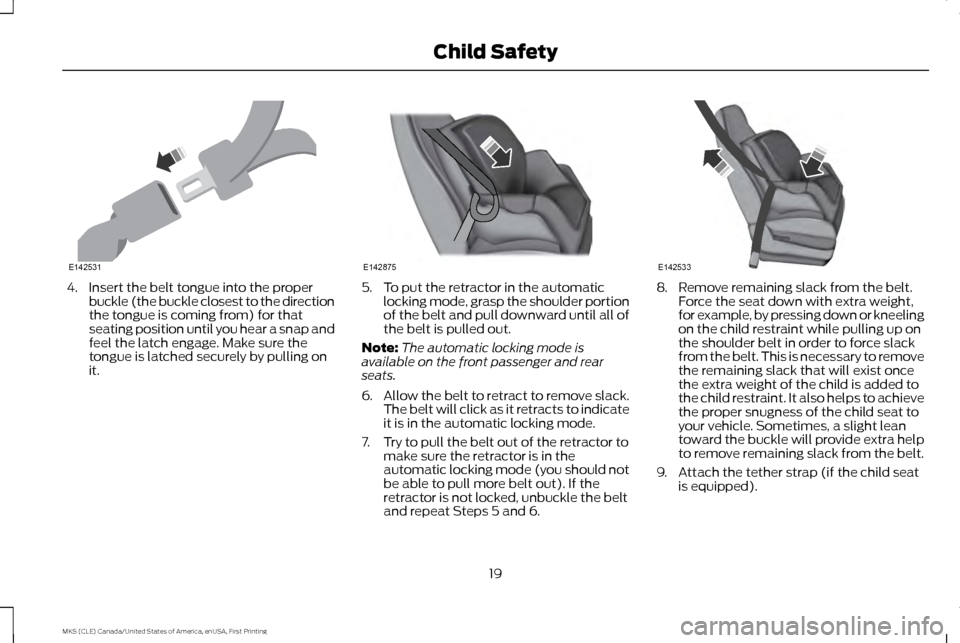
4. Insert the belt tongue into the proper
buckle (the buckle closest to the direction
the tongue is coming from) for that
seating position until you hear a snap and
feel the latch engage. Make sure the
tongue is latched securely by pulling on
it. 5. To put the retractor in the automatic
locking mode, grasp the shoulder portion
of the belt and pull downward until all of
the belt is pulled out.
Note: The automatic locking mode is
available on the front passenger and rear
seats.
6. Allow the belt to retract to remove slack.
The belt will click as it retracts to indicate
it is in the automatic locking mode.
7. Try to pull the belt out of the retractor to make sure the retractor is in the
automatic locking mode (you should not
be able to pull more belt out). If the
retractor is not locked, unbuckle the belt
and repeat Steps 5 and 6. 8. Remove remaining slack from the belt.
Force the seat down with extra weight,
for example, by pressing down or kneeling
on the child restraint while pulling up on
the shoulder belt in order to force slack
from the belt. This is necessary to remove
the remaining slack that will exist once
the extra weight of the child is added to
the child restraint. It also helps to achieve
the proper snugness of the child seat to
your vehicle. Sometimes, a slight lean
toward the buckle will provide extra help
to remove remaining slack from the belt.
9. Attach the tether strap (if the child seat is equipped).
19
MKS (CLE) Canada/United States of America, enUSA, First Printing Child SafetyE142531 E142875 E142533
Page 23 of 382
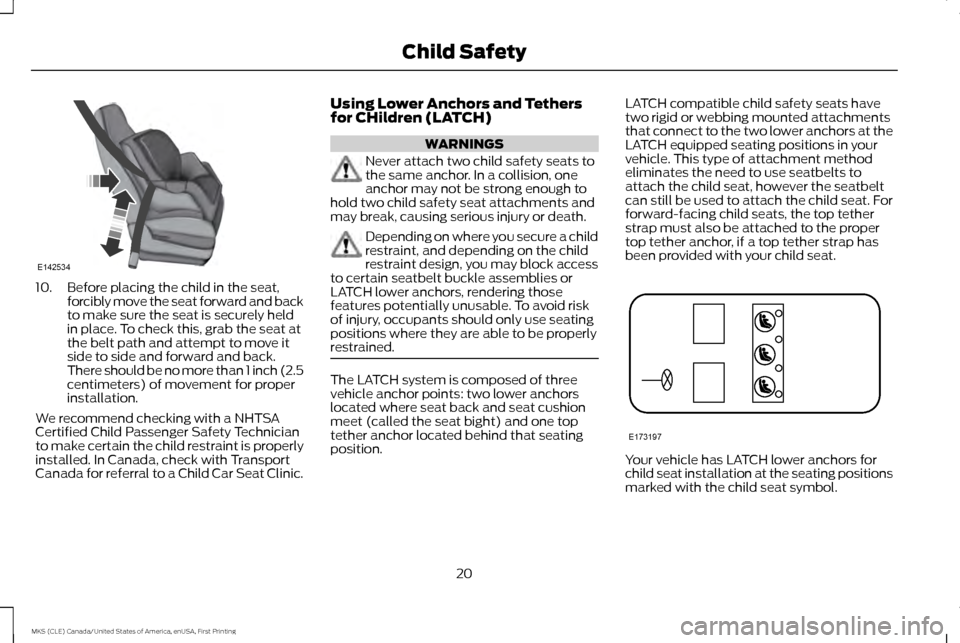
10. Before placing the child in the seat,
forcibly move the seat forward and back
to make sure the seat is securely held
in place. To check this, grab the seat at
the belt path and attempt to move it
side to side and forward and back.
There should be no more than 1 inch (2.5
centimeters) of movement for proper
installation.
We recommend checking with a NHTSA
Certified Child Passenger Safety Technician
to make certain the child restraint is properly
installed. In Canada, check with Transport
Canada for referral to a Child Car Seat Clinic. Using Lower Anchors and Tethers
for CHildren (LATCH) WARNINGS
Never attach two child safety seats to
the same anchor. In a collision, one
anchor may not be strong enough to
hold two child safety seat attachments and
may break, causing serious injury or death. Depending on where you secure a child
restraint, and depending on the child
restraint design, you may block access
to certain seatbelt buckle assemblies or
LATCH lower anchors, rendering those
features potentially unusable. To avoid risk
of injury, occupants should only use seating
positions where they are able to be properly
restrained. The LATCH system is composed of three
vehicle anchor points: two lower anchors
located where seat back and seat cushion
meet (called the seat bight) and one top
tether anchor located behind that seating
position.LATCH compatible child safety seats have
two rigid or webbing mounted attachments
that connect to the two lower anchors at the
LATCH equipped seating positions in your
vehicle. This type of attachment method
eliminates the need to use seatbelts to
attach the child seat, however the seatbelt
can still be used to attach the child seat. For
forward-facing child seats, the top tether
strap must also be attached to the proper
top tether anchor, if a top tether strap has
been provided with your child seat.
Your vehicle has LATCH lower anchors for
child seat installation at the seating positions
marked with the child seat symbol.
20
MKS (CLE) Canada/United States of America, enUSA, First Printing Child SafetyE142534 E173197
Page 24 of 382
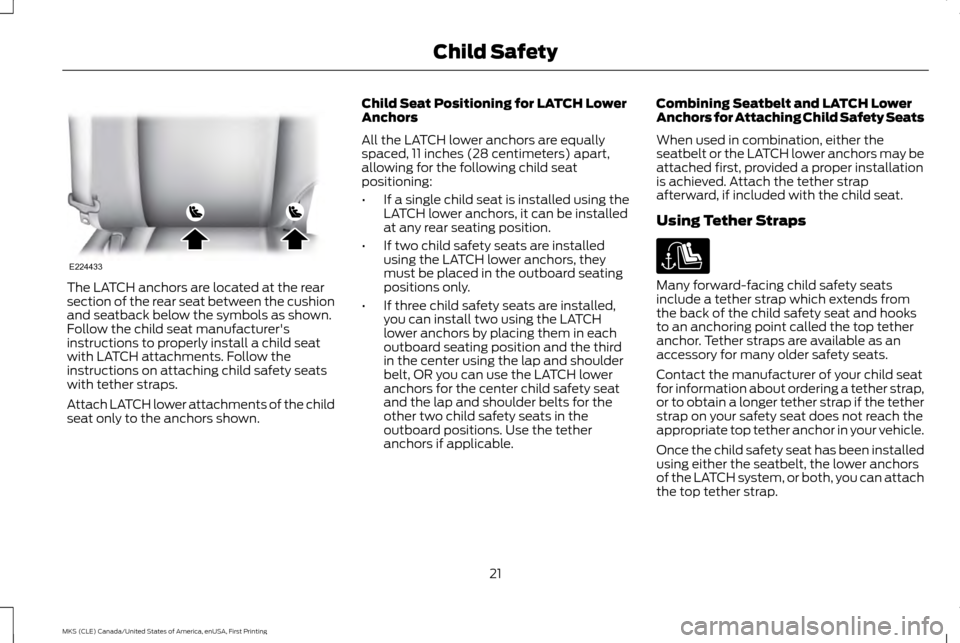
The LATCH anchors are located at the rear
section of the rear seat between the cushion
and seatback below the symbols as shown.
Follow the child seat manufacturer's
instructions to properly install a child seat
with LATCH attachments. Follow the
instructions on attaching child safety seats
with tether straps.
Attach LATCH lower attachments of the child
seat only to the anchors shown.
Child Seat Positioning for LATCH Lower
Anchors
All the LATCH lower anchors are equally
spaced, 11 inches (28 centimeters) apart,
allowing for the following child seat
positioning:
•
If a single child seat is installed using the
LATCH lower anchors, it can be installed
at any rear seating position.
• If two child safety seats are installed
using the LATCH lower anchors, they
must be placed in the outboard seating
positions only.
• If three child safety seats are installed,
you can install two using the LATCH
lower anchors by placing them in each
outboard seating position and the third
in the center using the lap and shoulder
belt, OR you can use the LATCH lower
anchors for the center child safety seat
and the lap and shoulder belts for the
other two child safety seats in the
outboard positions. Use the tether
anchors if applicable. Combining Seatbelt and LATCH Lower
Anchors for Attaching Child Safety Seats
When used in combination, either the
seatbelt or the LATCH lower anchors may be
attached first, provided a proper installation
is achieved. Attach the tether strap
afterward, if included with the child seat.
Using Tether Straps
Many forward-facing child safety seats
include a tether strap which extends from
the back of the child safety seat and hooks
to an anchoring point called the top tether
anchor. Tether straps are available as an
accessory for many older safety seats.
Contact the manufacturer of your child seat
for information about ordering a tether strap,
or to obtain a longer tether strap if the tether
strap on your safety seat does not reach the
appropriate top tether anchor in your vehicle.
Once the child safety seat has been installed
using either the seatbelt, the lower anchors
of the LATCH system, or both, you can attach
the top tether strap.
21
MKS (CLE) Canada/United States of America, enUSA, First Printing Child SafetyE224433
Page 26 of 382
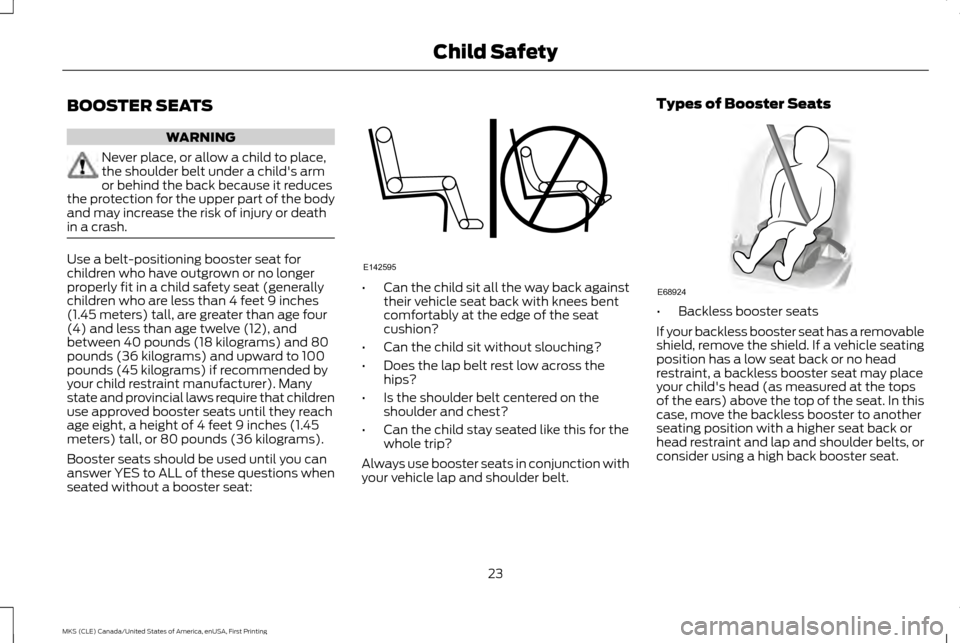
BOOSTER SEATS
WARNING
Never place, or allow a child to place,
the shoulder belt under a child's arm
or behind the back because it reduces
the protection for the upper part of the body
and may increase the risk of injury or death
in a crash. Use a belt-positioning booster seat for
children who have outgrown or no longer
properly fit in a child safety seat (generally
children who are less than 4 feet 9 inches
(1.45 meters) tall, are greater than age four
(4) and less than age twelve (12), and
between 40 pounds (18 kilograms) and 80
pounds (36 kilograms) and upward to 100
pounds (45 kilograms) if recommended by
your child restraint manufacturer). Many
state and provincial laws require that children
use approved booster seats until they reach
age eight, a height of 4 feet 9 inches (1.45
meters) tall, or 80 pounds (36 kilograms).
Booster seats should be used until you can
answer YES to ALL of these questions when
seated without a booster seat:
•
Can the child sit all the way back against
their vehicle seat back with knees bent
comfortably at the edge of the seat
cushion?
• Can the child sit without slouching?
• Does the lap belt rest low across the
hips?
• Is the shoulder belt centered on the
shoulder and chest?
• Can the child stay seated like this for the
whole trip?
Always use booster seats in conjunction with
your vehicle lap and shoulder belt. Types of Booster Seats
•
Backless booster seats
If your backless booster seat has a removable
shield, remove the shield. If a vehicle seating
position has a low seat back or no head
restraint, a backless booster seat may place
your child's head (as measured at the tops
of the ears) above the top of the seat. In this
case, move the backless booster to another
seating position with a higher seat back or
head restraint and lap and shoulder belts, or
consider using a high back booster seat.
23
MKS (CLE) Canada/United States of America, enUSA, First Printing Child SafetyE142595 E68924